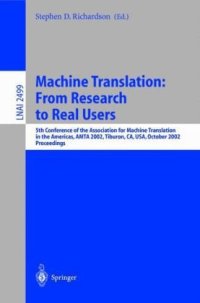
Ebook: Machine Translation: From Research to Real Users: 5th Conference of the Association for Machine Translation in the Americas, AMTA 2002 Tiburon, CA, USA, October 8 – 12, 2002 Proceedings
- Genre: Technique
- Tags: Artificial Intelligence (incl. Robotics), Mathematical Logic and Formal Languages, Language Translation and Linguistics
- Series: Lecture Notes in Computer Science 2499 : Lecture Notes in Artificial Intelligence
- Year: 2002
- Publisher: Springer-Verlag Berlin Heidelberg
- Edition: 1
- Language: English
- pdf
AMTA 2002: From Research to Real Users Ever since the showdown between Empiricists and Rationalists a decade ago at TMI 92, MT researchers have hotly pursued promising paradigms for MT, including da- driven approaches (e.g., statistical, example-based) and hybrids that integrate these with more traditional rule-based components. During the same period, commercial MT systems with standard transfer archit- tures have evolved along a parallel and almost unrelated track, increasing their cov- age (primarily through manual update of their lexicons, we assume) and achieving much broader acceptance and usage, principally through the medium of the Internet. Webpage translators have become commonplace; a number of online translation s- vices have appeared, including in their offerings both raw and postedited MT; and large corporations have been turning increasingly to MT to address the exigencies of global communication. Still, the output of the transfer-based systems employed in this expansion represents but a small drop in the ever-growing translation marketplace bucket.
This book constitutes the refereed proceedings of the 5th Conference of the Association for Machine Translation in the Americas, AMTA 2002, held in Tiburon, CA, USA, in October 2002. The 18 revised full technical papers, 3 user studies, and 9 system descriptions presented were carefully reviewed and selected for inclusion in the book. Among the issues addressed are hybrid translation environments, resource-limited MT, statistical word-level alignment, word formation rules, rule learning, web-based MT, translation divergences, example-based MT, data-driven MT, classification, contextual translation, the lexicon building process, commercial MT systems, speeck-to-speech translation, and language checking systems.